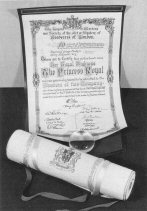Livery Companies
The Livery Companies probably had their origins in this country before 1066 and are similar to the fraternities and guilds (mysteries) that flourished throughout Europe for many centuries. The term “mystery” is still in use and derives from the Latin “misterium” meaning “professional skill”. The development of guilds and their continuing existence was not confined to London. Many major cities throughout Britain had craft guilds, some of which still exist, including the Cutlers of Hallamshire in Sheffield, the Merchant Venturers of Bristol, and the Feltmongers of Richmond in Yorkshire. Both Scotland and Ireland have a strong guild tradition which is still very active, while similar guilds also exist in many countries in continental Europe, where Switzerland, France and Germany have particularly strong and active guild organisations. Their present day functions vary considerably but are all based on trade and craft support.
To this day in the City of London names such as Milk Street, Bread Street, Ironmonger Lane, Poultry, Cloth Fair and Mason’s Avenue mark the sites where it all began. People following the same craft or trade tended to live and work near each other and they began to make informal arrangements amongst themselves for regulating competition and keeping professional standards high for mutual benefit. The earliest reliable historical record in England is probably the Royal Charter granted to the Weavers’ Company in 1155. By this time it is believed that many guilds were already organised and active in the support and regulation of their trade or craft. Members paid to belong and the world guild derives from the Saxon “gildan”, meaning “to pay”.

To a greater or lesser extent, these early guilds controlled the provision of services and manufacture and selling of goods and food in the City of London. This prevented unlimited competition and helped to keep wages and working conditions steady in extremely unstable time. The guilds protected their customers, employers and employees by checking for inferior work that did not meet their standards, was of bad quality, or underweight. The thirteen loaves of the “Baker’s Dozen” originated in these early days of strict regulations. Fines and other penalties for selling bad food or shoddy goods could be severe, culminating in expulsion and so the loss of livelihood.
Trade and domestic disputes were settled by arbitration at their Halls, which also served as a meeting place for their trade.
The welfare of members, both spiritual and material, has always been a major concern for the guilds. Members received help in sickness and in many cases almshouses were established. There was also a strong religious connection, with each guild having a Patron Saint and a link with a church or monastery, where regular guild services would be held and prayers said for departed members. Funerals were particularly important occasions, attended by all members of the company, when the coffin would be covered by fine cloths, a few of which are preserved to this day. The Fishmongers, Saddlers, Pewterers, Brewers, Girdlers, Parish Clerks, Vintners and Merchant Taylors each have a fine example.
In medieval times “livery” was the term used for the clothing, food and drink provided to the officers and retainers of great households, such as those of barons, bishops, colleges or guilds. The term became restricted to the distinctive clothing and badges which were symbols of privilege and protection. Since the members of each guild were distinguished from other people in this way, the guilds gradually became known as livery companies. It is still the custom to wear ceremonial dress on official occasions.
Organisation and Traditions

The Scroll and Casket presented to H.R.H The Princess Royal on her admittance to the Freedom of the Company in 1961
The members of the company were typically of four classes:-
- Apprentices* – normally serving a seven year apprenticeship.
- Journeymen* (sometimes Yeomen) – craftsmen who had served their apprenticeship but still had to obtain the Freedom of the City of London, and thus certified to be responsible citizens, before they could work at their trade.
- Freemen – those who had obtained the Freedom of the Company but were not yet full Liverymen of their Company.
- Liverymen - those who had set up in business on their own, were Freemen of the City, had been admitted as full members of the Company and could eventually become members of the Court.
* Apprentices and Journeymen are no longer classes of membership in the Broderers today.
